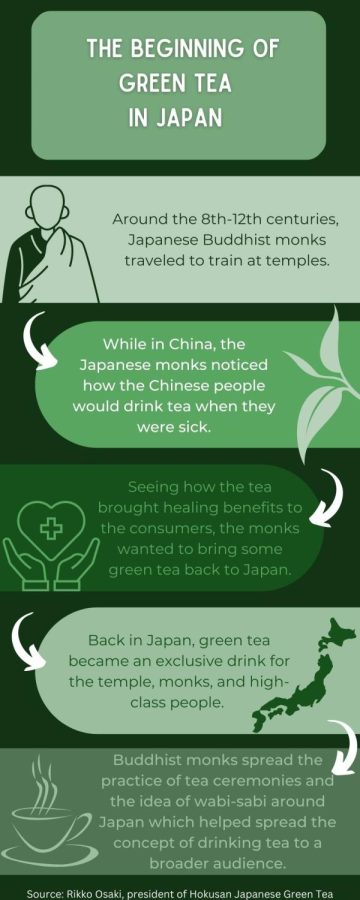
Twitter: @glyjournalism
October 23, 2022
Matcha is a powdered form of green tea, treated in a particular way to enhance its deep flavor.
This powdered green tea’s rich history is rooted in China, the place of origin for green tea and the practice of making powdered tea.
China discovered tea around 2737 BC, according to an article by United Kingdom Tea & Infusions Association (UKTIA), a non-profit association focused on supporting the tea and herbal infusions industry. Legend claims that Chinese Emperor Shennong discovered tea while sitting under a Camellia sinensis tree. Some leaves floated into the water his servant was boiling and created the first infused tea.
Then, tea found its way to Japan multiple times through Buddhist monks.

According to a history article by Marukyu Koyamaen, a tea growing, procuring, and blending company, Buddhist monks, Saicho and Kukai, brought tea leaves to Japan around the eighth century. They consumed it through tea blocks called Dancha. However, this soon lost popularity in Japan.
Later in the 11th century, tea remade its way back to Japan, according to Rikko Osaki, president of Hokusan Japanese Green Tea.
“Buddhism was growing in Japan around the 11th century, so many Japanese monks traveled to China to train at the temples,” Osaki said. “On their mission in China, the monks noticed how drinking tea healed the sick and wanted to bring some back to Japan.”
The leading Buddhist monk, Eisai, brought tea back to Japan with the seeds he brought from China. Osaki unfolds a tale behind his exportation of tea.
“One monk [Eisai] saw the healing effects tea brought to the Chinese consumers, so he wanted to bring some back to Japan to treat his sick mother. Yet, because of strict rules prohibiting people from exporting goods from China to Japan, the monk had to sneak some seeds into his cane to bring seeds to Japan,” Osaki said.
Eisai also introduced the Song dynasty technique for preparing tea. The monk learned this technique of grounding tea leaves into a fine powder from China. Eisai spread this tea-making to the Japanese public, which is why it is similar to the modern powdered matcha sold by stores.
However, once green tea found its way to Japan, they took the role of truly specializing in the cultivation of matcha.
According to Osaki, making matcha powder is no easy task.
“It takes seven years for [new] tea plants to grow until farmers can actually harvest them, so they have no income until then,” Osaki said.
Yet, waiting for harvest is only the beginning of the lengthy process. The yearly shading process plays a vital role in the end result of matcha.
“There is a difference between regular green tea leaves and tencha leaves,” Osaki said. “Farmers simply picked regular green tea leaves throughout April. For tencha, we cover them around March for about a month.”
Some say matcha tastes sweet, while others say it tastes bitter, and sometimes even grassy. Matcha gets its different tastes throughout its shading process.
“Our company carries four different grades of matcha. The bigger the tea leaves grow, the more bitter and lower quality the matcha becomes. The highest grade is picked during the spring, from April to May. The second-grade matcha is picket between spring and summer seasons. The third-grade matcha is picked during the summer. We harvest the lowest grade during September through October when the matcha leaves are the most bitter and fully grown.” Osaki said.
The tencha leaves go through a further process in order to become matcha powder.
A cup full of matcha contains an ocean of history and hard work behind its green appearance.
